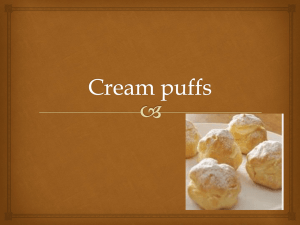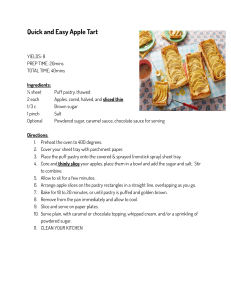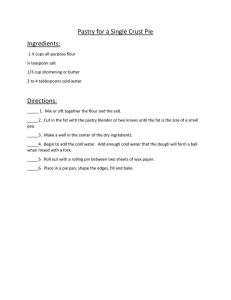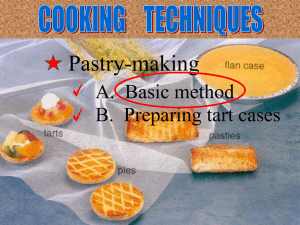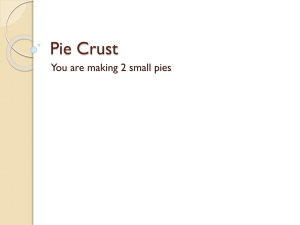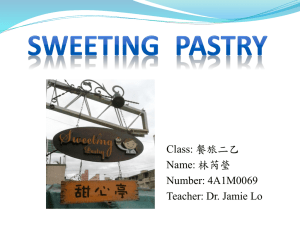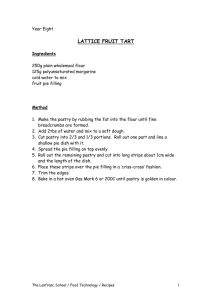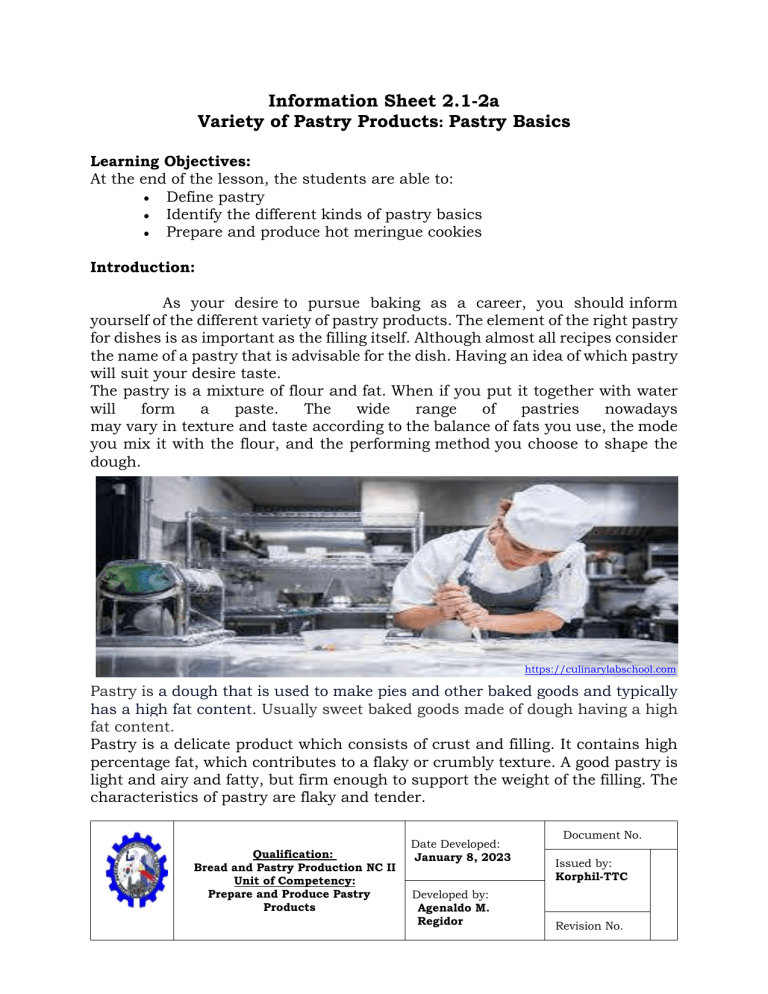
Information Sheet 2.1-2a Variety of Pastry Products: Pastry Basics Learning Objectives: At the end of the lesson, the students are able to: Define pastry Identify the different kinds of pastry basics Prepare and produce hot meringue cookies Introduction: As your desire to pursue baking as a career, you should inform yourself of the different variety of pastry products. The element of the right pastry for dishes is as important as the filling itself. Although almost all recipes consider the name of a pastry that is advisable for the dish. Having an idea of which pastry will suit your desire taste. The pastry is a mixture of flour and fat. When if you put it together with water will form a paste. The wide range of pastries nowadays may vary in texture and taste according to the balance of fats you use, the mode you mix it with the flour, and the performing method you choose to shape the dough. https://culinarylabschool.com Pastry is a dough that is used to make pies and other baked goods and typically has a high fat content. Usually sweet baked goods made of dough having a high fat content. Pastry is a delicate product which consists of crust and filling. It contains high percentage fat, which contributes to a flaky or crumbly texture. A good pastry is light and airy and fatty, but firm enough to support the weight of the filling. The characteristics of pastry are flaky and tender. Qualification: Bread and Pastry Production NC II Unit of Competency: Prepare and Produce Pastry Products Date Developed: January 8, 2023 Developed by: Agenaldo M. Regidor Document No. Issued by: Korphil-TTC Revision No. Kinds Pastry Products Pastries suggests many kinds of baked products made from a mixture of fat, flour and water. It includes a wide range of baked goods such as pies, tarts and special pastries. With pie crust, anyone can make a delicious dessert because many seasonal fruits go well with this. Also, a delicious and mouthwatering pizza can be made by just topping it with a selection of fruits, meat, cheese, vegetables and herbs 2 Classification of Pastry 1. Non-laminated Pastry - solid fat is cut into the flour, or added as melted or liquid oil. 2. Laminated Pastry - where solid fat is repeatedly folded into the dough using a technique called lamination. Pastry Basics 1. Pate Brisée and short pastries Pâte brisée (pot bree ZAY). Literally means “broken dough.” Same with the mealy pie dough, it is mixed by combining first the fat with the flour. This is also known as sablage (sah BLAHZH) or the sanding method in classical pastry. This is because the fat and flour is combined until the mixture is similar to a coarse meal or sand. This https://www.abakingjourney.com is done to avoid the flour to absorb water to limit the gluten development which results to a tender pastry. For a large tart, pâte brisée is used. Pâte sucrée (soo CRAY). This means “sugared dough.” Compared to pâte brisée, it contains higher amount of sugar which tenderize the dough. However, high sugar content makes the dough to become fragile and more difficult to handle than pâte brisée. https://cookthink.com Small items such as tartlets and petit fours uses this dough. It can be mixed either by the sablage method or the creaming method. In creaming method, fat and sugar are mixed first. This Qualification: Bread and Pastry Production NC II Unit of Competency: Prepare and Produce Pastry Products Date Developed: January 8, 2023 Developed by: Agenaldo M. Regidor Document No. Issued by: Korphil-TTC Revision No. method is also used for cookies, cakes, and muffins. Both pâte sucrée and, pâte sablée can be used to make plain cookies. Pâte sablée (sah BLAY) An extremely tender and crumbly dough. Compared to pâte sucrée, this contains even more fats and less egg and other moisturizers. In some formulas, it contains more sugar as well. Pâte sablée is often called a 1-23 dough, because it contains 1 part sugar, 2 parts fat, and 3 parts flour by weight. It can be mixed using the sablage method but today, it is more common to https://www.750g.com/recettes_pate_sablee.htm use the creaming method. This dough is generally used for cookies and for small tarts and other pastries. In French, sable means “sand” and its crumbly or sandy texture gives the pastry its name. 2. Puff Pastry - Like Danish and croissant doughs puff pastry (pâte feuilletée) is laminated and rolled-in. It is made up of many layers of fat in between layers of dough. Although puff pastry does not contain yeast, steam serves as its raising agent in the oven. https://tasty.co/recipe/puff-pastry-breakfast-cups Light and flaky pastry made from a laminated dough, or dough that is made by alternating layers of butter and dough. The only ingredients used to make puff pastry are butter, salt, water, and flour — no leavening agents are required. The fat and air being trapped between the layers of the pastry dough to give a flimsy, light and crisp finish. 3. Choux Pastry - This is a very light pastry that is often filled with various flavors of cream and is often topped with chocolate. It can also be used as appetizers when filled with cheese, tuna, or chicken. The word choux in French means cabbage, and choux pastry gets its name from the fact that the little balls of choux paste used to make cream https://www.seriouseats.com/choux-pastry puffs resemble little cabbages. This Qualification: Bread and Pastry Production NC II Unit of Competency: Prepare and Produce Pastry Products Date Developed: January 8, 2023 Developed by: Agenaldo M. Regidor Document No. Issued by: Korphil-TTC Revision No. pastry is made with flour, butter, eggs, and water or milk. It is leavened with steam, and cooked twice, once on the stovetop and again in the oven. It is characterized by a crispy outer shell with a light, airy interior. 4. Strudel and Phyllo - Desserts made of strudel or phyllo dough start out with paper-thin layers brushed with fat and then stacked or rolled up to make manylayered creations. Unlike puff pastries, these doughs are even flakier. Strudel is a soft dough made of strong flour, eggs and water originated in Eastern Europe. It uses strong flour to stand stretching by hand to form it into a very thin transparent sheet. This skill takes practice https://www.cookingclassy.com to be done well. Phyllo dough (FEE-lo, sometimes spelled “filo” or “fillo”). This is a Greek version type of paper-thin dough. It is widely used today and is interchangeable for strudel dough although it is not exactly the same as strudel. In fact, commercial phyllo is often labeled “phyllo/strudel dough. This type of pastry is made in very thin sheets and used as a casing for numerous delicate savoury and sweet dishes. Made with high gluten content flour, filo is very difficult to make and needs careful handling because it is such a thin, fragile pastry that dries out quickly. It must be brushed with oil or melted butter before shaping and cooking. 5. Baked meringues - is made by whipping egg whites with sugar into a stiff foam or frothy mixture. Usually, a small amount of acid is added to improve volume, stability and color. It can also be made with hot sugar syrup and other stabilizing agents, mainly hydrocolloids. Meringue is a familiar topping for pastries and sweet goods. It can also be used as a main component which goes well with the composition of batters or foams. Baked https://www.cookingclassy.com meringues although it may seem odd, is used in many of the same ways as flour pastry. It is bagged out into shapes and baked until crisp. It can be filled or iced with many kinds of creams, icings, and fruits to make an interesting variety of attractive desserts.9 Qualification: Bread and Pastry Production NC II Unit of Competency: Prepare and Produce Pastry Products Date Developed: January 8, 2023 Developed by: Agenaldo M. Regidor Document No. Issued by: Korphil-TTC Revision No. Common meringue and Swiss meringue are generally used in making crisp, baked shells. Japonaise is a special meringue that contains nuts. This is usually made into round, crisp layers. It can be filled and iced with buttercream, chocolate mousse, whipped cream, or similar light icings and creams A few products with meringue are: Cream or chiffon pie Sponge, foam, or chocolate velvet cake Parisian macarons Italian (boiled) meringue Marshmallow Meringue Formulation and Process Ingredient Baker’s % (based on flour weight) Liquid egg whites* 100.0 Cream of tartar 1.0–3.0 Sugar (refined, granulated)** 60.0 *Can be frozen, pasteurized/refrigerated (liquid) or dried. **Superfine granulated sugar can also be used. This type of sugar contains crystals that are intermediate in size between powdered sugar and regular granulated sugar. Superfine sugar dissolves more quickly in liquids than regular granulated sugar, thus allowing the incorporation of smaller air cells into the foam. Preparation of meringue Two methods are commonly used: 1. Cold meringue method: the egg whites are beaten until stiff, then sugar is gradually added. The mixture is whipped until desired consistency. 2. Hot meringue method: water is boiled and a slurry of starch is added. Sugar is incorporated into the boiling mixture until it thickens. When the whipped egg white reach a medium peak, the hot syrup is gradually added. This method is beneficial in preventing weeping of the meringue mass. Other thickeners may be used in place of starch. Qualification: Bread and Pastry Production NC II Unit of Competency: Prepare and Produce Pastry Products Date Developed: January 8, 2023 Developed by: Agenaldo M. Regidor Document No. Issued by: Korphil-TTC Revision No. A variety of meringue bases and egg-free alternatives are also available for bakers. Variations There are many variations of this dessert. The most common additions are vanilla, coconut, and almond extract. Fruit is sometimes added to give unique flavors. French meringue is the most common recipe made at home and is simply egg whites, sugar, and cream of tartar mixed together. During baking at 392°F (200°C) the egg protein denatures completely, loses its elasticity and sets to a firm structure. Italian (boiled) meringue is stiffer and more stable than French meringue. It’s made by boiling sugar-water mix to a hard ball stage of 250°F (121°C). Then, it’s poured over well-beaten egg whites. This cooks the egg whites as it is made, allowing consumption of this meringue without baking. Application In preparing meringues and similar whipped goods, there is a stage at which the mixture will form a persistent point when the beater is pulled vertically from the beaten mixture. When short and stiff, it is called a dry peak. When the peak is long, soft, and tends to bend over, it is called a wet peak. During mixing or whipping, air is incorporated and entrapped by the egg foam. This causes the product to become light and porous. Specific gravity is often used as an indicator to determine proper mixing of the foam. The longer the whipping, the lower the specific gravity, the firmer and the drier the foam will be. General recommendations when using egg products Frozen egg products should be thawed under refrigeration for up to 48 hours, then stirred before using. Dried egg whites need to be reconstituted in water before use according to the manufacturer’s instructions. When using alternative forms for egg whites, follow supplier instructions if reconstitution with water, supplementation and liquid/solids balancing are needed. Dried egg products must be stored under refrigeration. Pasteurized eggs are recommended when the preparation requiring eggs will not be cooked, such as for an unbaked meringue pie topping. Qualification: Bread and Pastry Production NC II Unit of Competency: Prepare and Produce Pastry Products Date Developed: January 8, 2023 Developed by: Agenaldo M. Regidor Document No. Issued by: Korphil-TTC Revision No. When determining liquids in formula balance, it is important to remember that egg whites are 12% solid (sugar and protein) and 88% liquid. How to make Meringue cookies Ingredients 3 egg whites ¼ tsp cream of tartar ¼ cup granulated sugar Procedures 1. Make a meringue. In a clean mixing bowl fitted with the whisk attachment, beat egg whites and salt on high until the whites start to foam. Gradually add the granulated sugar one tablespoon at a time and allow the egg whites to eventually form stiff peaks. It will appear shiny and smooth. Add the vanilla extract and combine. If adding food coloring, you can add it now. 2. Fold in powdered sugar. Using a rubber spatula, fold in sifted powdered sugar until completely incorporated. If adding 3. Bake. Place small heaps of meringue on a parchment-lined sheet pan or pipe them evenly in rows using a piping bag and a round or star piping tip. Bake for 2-3 hours on the lowest shelf in your oven at 200°F/90°C until the meringues are completely dry. Cool completely. Qualification: Bread and Pastry Production NC II Unit of Competency: Prepare and Produce Pastry Products Date Developed: January 8, 2023 Developed by: Agenaldo M. Regidor Document No. Issued by: Korphil-TTC Revision No. Self-Check 2.1-2a Direction: Answer the following questions and Identify what is being asked. Write your answer in the space provided. ______________1. It is made by whipping egg whites with sugar into a stiff foam or frothy mixture. ______________2. It is made from flour with a high gluten content, water, oil and salt, with no sugar added. ______________3. This is a Greek version type of paper-thin dough. ______________4. It is characterized by a crispy outer shell with a light, airy interior. ______________5. Made from a laminated dough, or dough that is made by alternating layers of butter and dough. ______________6. It is a rich, slightly crumbly pastry with a higher ratio of fat to flour than some other pastry recipes. ______________7. Where solid fat is repeatedly folded into the dough using a technique called lamination. ______________8. Solid fat is cut into the flour, or added as melted or liquid oil. ______________9. A mixture of flour and fat. When if you put it together with water will form a paste. ______________10. Often used as an indicator to determine proper mixing of the foam. ______________11. Literally means “broken dough.” Same with the mealy pie dough, it is mixed by combining first the fat with the flour. ______________12. This means “sugared dough.” It contains higher amount of sugar which tenderize the dough. ______________13. An extremely tender and crumbly dough. This contains even more fats and less egg and other moisturizers ______________14. Like Danish and croissant doughs which is laminated and rolled-in. ______________15. A soft dough made of strong flour, eggs and water originated in Eastern Europe. Qualification: Bread and Pastry Production NC II Unit of Competency: Prepare and Produce Pastry Products Date Developed: January 8, 2023 Developed by: Agenaldo M. Regidor Document No. Issued by: Korphil-TTC Revision No. ANSWER KEY 2.1-2a 1. Baked meringues 2. Strudel pastry 3. Filo Pastry 4. Choux Pastry 5. Puff Pastry 6. Sweet shortcrust pastry 7. Laminated Pastry 8. Non-laminated Pastry 9. Pastry 10. Specific gravity 11. Pâte brisée 12. Pâte sucrée 13. Pâte sablée 14. Puff Pastry (pâte feuilletée) 15. Strudel Qualification: Bread and Pastry Production NC II Unit of Competency: Prepare and Produce Pastry Products Date Developed: January 8, 2023 Developed by: Agenaldo M. Regidor Document No. Issued by: Korphil-TTC Revision No. TASK SHEET 2.1-2a Title: Prepare and produce hot meringue cookies Performance Objective: Given the ingredients, tools materials, equipment and recipe you are able to prepare and produce hot meringue cookies in 1 hour Egg whites, cream of tartar, granulated sugar food color and vanilla extract Supplies/Materials Equipment : Steps/Procedure: Assessment Method: Oven, blender with attachment 1. Make a meringue. In a clean mixing bowl fitted with the whisk attachment, beat egg whites and salt on high until the whites start to foam. Gradually add the granulated sugar one tablespoon at a time and allow the egg whites to eventually form stiff peaks. It will appear shiny and smooth. Add the vanilla extract and combine. If adding food coloring, you can add it now. 2. Fold in powdered sugar. Using a rubber spatula, fold in sifted powdered sugar until completely incorporated. If adding 3. Bake. Place small heaps of meringue on a parchment-lined sheet pan or pipe them evenly in rows using a piping bag and a round or star piping tip. Bake for 1 hour on the lowest shelf in your oven at 200°F/90°C until the meringues are completely dry. Cool completely. Demonstration Evaluation using performance criteria Qualification: Bread and Pastry Production NC II Unit of Competency: Prepare and Produce Pastry Products Date Developed: January 8, 2023 Developed by: Agenaldo M. Regidor Document No. Issued by: Korphil-TTC Revision No. Performance Criteria Checklist 2.1-2a CRITERIA YES Did you... NO Mise en place all the ingredients? Used appropriate tools and equipment? Beat egg whites and salt on high until the whites start to foam Gradually stir in water until dough holds together enough to clean the sides of the bowl? Add the granulated sugar one tablespoon at a time and allow the egg whites to eventually form stiff peaks? Fold in powdered sugar using a rubber spatula? Place small heaps of meringue on a parchment-lined sheet pan? Used a piping bag and a round or star piping tip? Bake for 1 hour on the lowest shelf in your oven at 200°F/90°C until the meringues are completely dry? Qualification: Bread and Pastry Production NC II Unit of Competency: Prepare and Produce Pastry Products Date Developed: January 8, 2023 Developed by: Agenaldo M. Regidor Document No. Issued by: Korphil-TTC Revision No.
